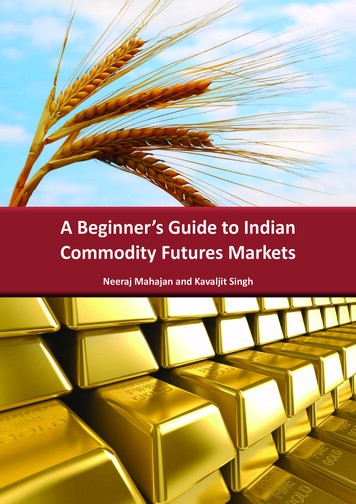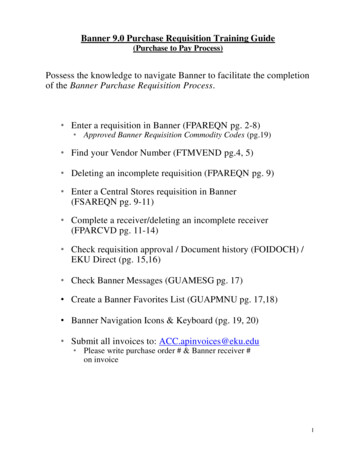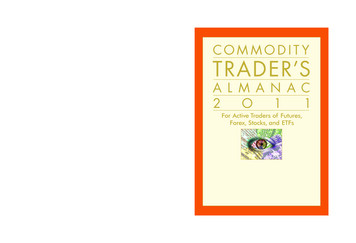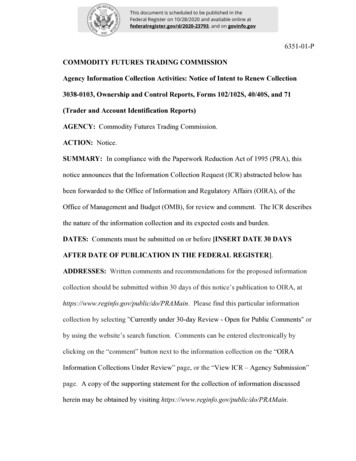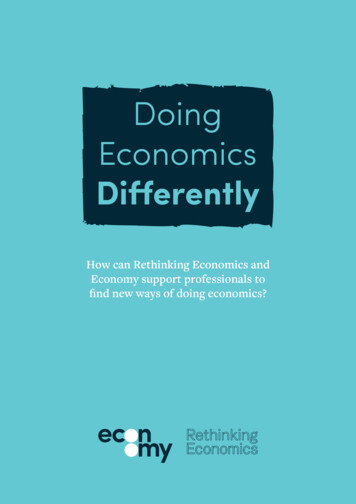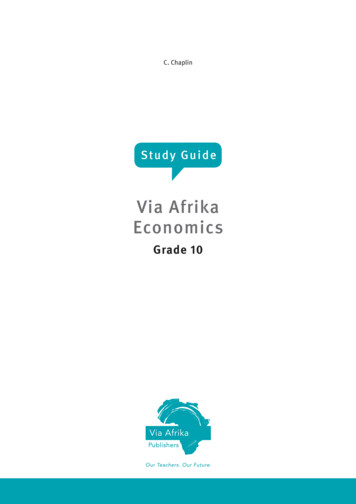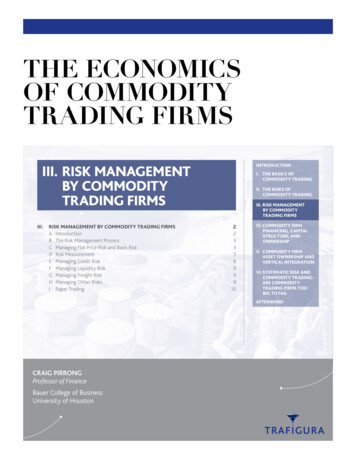
Transcription
THE ECONOMICSOF COMMODITYTRADING FIRMSINTRODUCTIONIII. RISK MANAGEMENTBY COMMODITYTRADING FIRMSIII.RISK MANAGEMENT BY COMMODITY TRADING FIRMS A Introduction B The Risk Management Process C Managing Flat Price Risk and Basis Risk D Risk Measurement E Managing Credit Risk F Managing Liquidity Risk G Managing Freight Risk H Managing Other Risks I Paper Trading I. THE BASICS OFCOMMODITY TRADINGII. THE RISKS OFCOMMODITY TRADINGIII. RISK MANAGEMENTBY COMMODITYTRADING FIRMS22335899910IV. COMMODITY FIRMFINANCING, CAPITALSTRUCTURE, ANDOWNERSHIPV. COMMODITY FIRMASSET OWNERSHIP ANDVERTICAL INTEGRATIONVI. SYSTEMATIC RISK ANDCOMMODITY TRADING:ARE COMMODITYTRADING FIRMS TOOBIG TO FAILAFTERWORDCRAIG PIRRONGProfessor of FinanceBauer College of BusinessUniversity of Houston
SECTION IIIIII. RISK MANAGEMENT BY COMMODITYTRADING FIRMSSUMMARYThis section examines risk management systems and processes in one company to developa more granular picture.Risk management at Trafigura is highly centralized. A Chief Risk Officer has overallresponsibility. A Risk Committee and a Derivatives Trading Committee assess riskconcentrations and set limits.Trading desks operate within centrally determined parameters. Outright market pricerisks are almost always hedged via futures or swaps. Basis risks are managed in financialmarkets. Hedges are executed through an internal broker and overall risk is consolidatedat Group level.Asset heavy firms areusually less highlyleveragedTrafigura has invested 550 million over the last three years in risk management andmeasurement systems. The company’s Value-at-Risk (VaR) model combines 5,000 risk factors to assess netexposure. It uses Monte-Carlo simulations to predict P&L outcomes in multiplescenarios. Its VaR target is 95% confidence that its maximum one-day loss is lessthan 1% of Group equity. Trafigura augments its VaR data with stress tests and analysis that estimate P&Loutcomes in extreme scenarios. Trafigura’s enhanced VaR analysis addresses many, but not all, of VaR’s deficiencies.The company therefore supplements this analysis with qualitative assessment.Trafigura has experienced a low rate of credit losses in its history. A formal processassigns a credit limit for each counterparty. It typically bears less than 20% of tradingcounterparty credit risk and transfers the remainder to financial institutions.The company manages liquidity risk by diversifying types of funding and providers of funding.Trafigura manages freight risk using Forward Freight Agreements and fuel swaps.It manages operational risks through a combination of liability insurance, best practiceprocedures, and Group-wide quality controls. It has a comprehensive framework for health,safety, environmental, and community (HSEC) performance.The company and its subsidiary Galena Asset Management also engage in speculativepaper trading. This takes advantage of Trafigura’s industry knowledge. Traders dealin calendar and intra-market spreads; they have very little exposure to flat price risk.A. INTRODUCTIONTrading firms have always been at the forefront of the management of commodity price risk.This fact was recognized by one of the first great scholars of futures markets, HolbrookWorking. Working noted that open interest in futures markets (the number of outstandingcontracts) varied with the amount of a crop that was in the hands of merchandisers. Openinterest was bigger for commodities like wheat that was largely marketed, rather than heldby farmers to feed livestock, than it was for corn, which was held by farmers as a feed grainin far larger proportion. Similarly, Working noted that the seasonal patterns in open interestmatched crop marketing patterns, with open interest reaching its maximum some time afterthe harvest, and hence after farmers had sold the crop to merchandisers. From these facts,Working concluded that commodity merchants who transformed wheat, corn, and cottonin space and time were the primary users of futures contracts, and that they used thesecontracts to hedge their risk.Commodity trading firms remain major users of futures contracts, and other derivativescontracts, as a centerpiece of their risk management programs. Viewing logistics, storage,and other transformations as their core businesses, they do not have a comparativeadvantage in bearing flat price risks. As a result, they hedge most price risks using exchangetraded (“listed”) or over-the-counter derivatives.2
SECTION IIIAlthough as a general rule commodity trading firms are hedgers, firms have different riskmanagement policies, pursue different risk management strategies, and have differentrisk management procedures in place. Moreover, although commodity price risk is arguablythe largest risk for most trading firms, other risks, notably credit and operational risks,are also material and involve their own company-specific policies, procedures, and strategies.Therefore, it is impractical to characterize in detail risk management by commodity tradersgenerally, and I focus on Trafigura as a representative example of how commodity tradersmanage risk. A review of the disclosures of some publicly traded commodity trading firmssuggests that Trafigura’s approach to risk management is broadly representative of majorcommodity firms generally.Trafigura’s riskmanagement isrepresentativeof the industryB. THE RISK MANAGEMENT PROCESSRisk management in Trafigura is highly centralized. The company has a Chief Risk Officer(“CRO”) who reports directly to the Chief Operating Officer (“COO”) and the ManagementBoard. The CRO is a member of the Risk Committee, which also includes company directorsand senior traders. The Committee meets regularly to assess and manage risk exposures,and to adjust strategies in light of prevailing market conditions. The CRO performs functionssuch as overseeing the refinement of risk models, the review and testing of model performance,and reviewing exposures across businesses. The CRO is independent of the “front office”revenue generating operations of the company.Risk managementis highly centralizedTrafigura also has a Derivatives Trading Committee that is responsible for implementing thecompany’s risk management policies. It evaluates risk limits and concentrations, and monitorsmarkets to identify emerging risks and opportunities.This process is highly dependent on the collection, analysis, and distribution of informationregarding risks. Some of this information is “hard” data on positions in both physicalcommodities and derivatives contracts. Other “hard” information includes data on currentand historical prices of the commodities that Trafigura trades, and models to analyze thisdata: I discuss risk measurement and risk modeling in more detail below. Using these data andanalytics, the firm produces quantitative measures of overall risk exposure, and the risks ofindividual trading books. The company establishes limits on these quantitative risk measures,both on a firm-wide basis and for each individual trading team. A team is notified when itsmeasured risk approaches its assigned limit.Quantitative datais criticalGiven the number of commodities that Trafigura trades, and the large number of prices(e.g., spot prices of various varieties of oil at various locations, futures prices for differentmaturities) collecting, storing, distributing, and analyzing this hard information is anextremely computationally and information technology intensive process. Largely as a resultof the computational demands of the risk management process, Trafigura has spent 550million on information technology hardware and software in the past three years. This isan overhead expense, and from the perspective of the industry overall, expenditures on riskmanagement information technology creates a scale and scope economy that tends to favorconsolidation of the industry into a smaller group of large firms, and which makes it moredifficult for smaller and more specialized firms to compete. The increasing data and analyticalintensity of trading and risk measurement modeling is tending to increase the degree of thesescale and scope economies.Other information is “softer”, more qualitative information about market conditions and marketdynamics. Trading desks constantly active in the market obtain this information, and provide itto the CRO, the Risk Committee and the Derivatives Trading Committee. The CRO, the RiskCommittee, the Derivatives Trading Committee and the Trading Desks collaborate to integrate,interpret, and analyze this information. They then utilize this analysis to assess and manage risks.Qualitativeinformation isalso importantC. MANAGING FLAT PRICE RISK AND BASIS RISKIt is standard practice at Trafigura to hedge market price risks where possible. Indeed, hedgingis required under the terms of some transactional financing arrangements. In the past(prior to 2007) the bank providing funding for a transaction controlled the hedge througha tripartite agreement (TPA) between it, the brokerage firm, and the client; this arrangementis still utilized for smaller and medium sized-traders. In this arrangement the bank has asecurity interest in the portfolio of derivatives and the product being hedged (e.g., a cargoof crude oil), and finances the margin calls on the futures.Market price risksare always hedgedwhere possibleAt present, however, Trafigura (and other larger traders) do not utilize this TPA mechanism,as it is operationally and administratively cumbersome. Instead, although the bank lendingagainst a physical position has a security interest against that inventory, and adjusts the3
SECTION IIIfinancing on a weekly basis (or perhaps more frequently under volatile conditions), it hasno interest in, or even view of, the futures or swap position used to hedge. Instead, Trafiguraand other traders operating in this way endeavor to hedge all the risk via futures or swaps,self-finance the initial margins (mainly out of corporate lines), and also finance anymismatches in variation margin payments: mismatches arise because futures (and someswaps) are marked to market daily, which results in daily variation margin payments, butas just noted normally the bank lending against inventory only marks its value to marketon a weekly basis.In addition to hedging inventories, Trafigura also routinely hedges future physicaltransactions. For instance, it may enter into an agreement to purchase crude from WestAfrica for delivery in two months at the Brent price plus/minus a differential, and enter intoanother contract to sell that cargo to a US refiner at the West Texas Intermediate price plus/minus a differential. This set of transactions exposes the company to fluctuations in theBrent-WTI differential, which it can, and routinely does, hedge by buying Brent futures andselling WTI futures.This type of transaction receives different accounting treatment than a hedge of a physicalinventory. Whereas the derivatives position associated with the physical inventoryis accounted for as a hedge, the derivatives used to hedge the forward floating pricetransactions are put in the trading book. These positions can represent a substantial fractionof Trafigura’s total net notional derivatives positions. For instance, as of September 30, 2011,the notional value of derivatives held for trading purposes represented approximately 45%of the total notional amount of Trafigura’s derivatives.1 Although as discussed later someof the derivatives held for trading purposes are fairly characterized as speculative (thoughmainly involving speculation on price differentials rather than flat prices), most are enteredfor the purpose of managing price risks.Future physicaltransactions areroutinely hedgedHedges are executedcentrally through aninternal brokerThe hedging process is rather mechanical and centralized. When the price on a physical trade(e.g., the purchase of a physical oil cargo) is fixed, the Deals Desk initiates a hedge. The hedgeis executed through a broker by the central execution desk of Trafigura Derivatives Limited (TDL):all hedges are also centrally booked through TDL, which acts as an internal broker for the group.There is thus a separation of the execution of physical trades from the management of themarket price risk associated with those trades, and the risk management function is centralized.Trafigura primarily utilizes futures and swaps to manage its risks. For instance, it typically hedgesthe purchase of a cargo of crude oil by selling oil futures or an oil swap. Options can be used tomanage risk as well, but Trafigura does not use them extensively in its hedging program.2Due to differences between the characteristics of the commodity being hedged, and thehedging instruments, no hedge is perfect, and Trafigura bears some residual risk. For instance,hedging a cargo of Nigerian crude with Brent crude futures or WTI crude futures involvesa mismatch in quality, location, and timing. Since these factors influence price, mismatchescause the prices of the hedge instrument and the commodity being hedged not to movein lockstep. Trafigura is at risk to changes in the difference between the price of the hedgedcommodity and the hedge instrument. This difference—the basis—is variable, due to thisdifferential movement in prices arising from the mismatches. Thus, a hedger like Trafigurais exposed to basis risk, and hedging involves the substitution of basis risk for flat price risk.Since the prices of hedging instruments and the commodities hedged are correlated, however,basis risk is typically substantially less than flat price risk.Trafigura mainly usesfutures and swaps tomanage riskThe amount of basis risk differs by commodity. For instance, whereas copper cathodes storedin an LME warehouse can be hedged quite effectively using LME copper futures, copperconcentrates can be hedged less effectively. The copper content in the concentrate can behedged, because many contracts for the sale of concentrates specify that one componentof the price will be based on copper content and the LME price: the LME price risk can behedged. But the other components of the price, notably treatment and refining charges,cannot be hedged, and are a source of basis risk.Basis risk can also vary over time. For instance, the basis tends to be more volatile wheninventories are low. Changes in the severity of constraints can also affect the variability1 Base Prospectus, Trafigura Funding S.A. (14 November, 2013) F-31-F-33.2 This illustrates that the firm aims to eliminate flat price exposure, because an option hedge leaves a (one-sided)exposure. For instance, a firm can hedge a cargo of crude against price declines by buying an oil put. This protects thefirm against price declines, but allows it to profit from price increases. Thus, an option hedge retains a price exposure,and due to its one-sided nature this hedge is costly: the firm must pay a premium to purchase the put. If the firm’sobjective is to eliminate price exposure, it can avoid this cost by merely selling futures as a hedge.4
SECTION IIIof the basis. For instance, the basis tends to be more variable when transportation capacityis tightly constrained than when it is not. As an extreme example, the basis between WTIat Cushing, Oklahoma and the prices of crude oil at the Gulf of Mexico exhibited relativelylittle variability when the main flow of oil was from the Gulf to the Midcontinent and therewas abundant pipeline transport capacity. When oil went into surplus at Cushing, and therewas no pipeline capacity to ship it to the Gulf, the basis became more variable.Trafigura manages basis risk using its knowledge of the relationships between prices of relatedbut different commodities. Moreover, just as Holbrook Working described in his writing onhedging by commodity traders in the 1950s, the traders use their marketplace knowledgeto try to predict future basis movements, and place their hedges to earn a profit from afavorable movements in the basis. Thus, to the extent that Trafigura speculates, most of itsspeculation is on basis relationships.It uses its marketknowledgeto manage basisrelationshipsThe underlying physical transactions and the hedges associated therewith are included in thecompany’s centralized risk measurement system (described below). The basis risk on a tradingbook’s position contributes to the overall risk of the firm. Moreover, the risk measurementsystem calculates the risk associated with a trading desk’s positions, and the trading desk issubject to risk limits: its measured risk cannot exceed the assigned limit. Furthermore, tradesare marked to market on a daily basis based on proprietary forward curves produced by theRisk Control Group, and exception reports are generated when a position incurs a change in valuein excess of 50,000. Traders have to explain the reason for the exception to senior management.Although traders attempt to manage basis risk through judicious design of hedges, this riskcannot be eliminated. However, to the extent that basis movements are uncorrelated acrossdifferent transactions, this risk can be reduced through diversification. In particular, giventhat basis movements in different commodities (e.g., oil and copper) are driven by differentfundamentals, they are likely to exhibit little correlation, and hence a firm that trades adiversified portfolio of commodities can reduce risk exposure. This provides an advantageto larger firms that participate in a variety of different commodities, engage in a varietyof transformations, and trade in many geographic markets.Trafigura’soverall risk isreduced throughdiversificationD. RISK MEASUREMENTWith respect to market price risks, a trading company such as Trafigura can be viewed as aportfolio of positions in a myriad of physical commodities and financial derivatives contracts(including futures contracts and swaps). Given information about the variability of the pricesassociated with individual positions, and the covariation between these prices, it is possibleto compute various measures of the risk of the overall portfolio.It monitorsValue-at-RiskConsistent with standard industry practice for trading generally (not just commodity trading),Trafigura employs Value-at-Risk (“VaR”) as its measure of the overall price risk of its portfolioof physical and derivatives trading positions. Value-at-Risk is defined as the amount of money,or more, that can be lost over a given time horizon with a given probability.Implementation of VaR requires the user to choose a probability level, and a time horizon.Consistent with standard industry practice, Trafigura uses a one-day time horizon, and a 95%probability (“confidence”) level. As of 30 September, 2013, Trafigura reported its VaR as 11.3million. This means that on 95% of trading days, the company would be expected to sufferlosses of less than 11.3 million. Put differently, on 5% of trading days, the firm could expectto lose more than 11.3 million.As noted above, the company has established a VaR target. Specifically, the firm attemptsto maintain VaR at less than 1% of group equity. Using equity to set the target reflects thefact that capital represents loss bearing capacity. Thus, the company compares the risk ofloss, as measured by VaR, to its risk bearing capacity.Again consistent with standard industry practice, Trafigura uses a simulation (“Monte Carlo”)method to calculate VaR. In particular, it uses a variant on the industry standard historicalsimulation VaR method. That is, it randomly draws changes in the prices of instruments inits portfolio from historical data. The company’s VaR system currently takes into accountover 5,000 risk factors. These include the forward prices for the commodities the firm trades,interest rates, foreign exchange rates, and equity prices. Based on these simulated pricemovements, the profits/losses on each position in the portfolio are calculated and then addedto determine the simulated profit/loss on the entire portfolio. It makes many such randomdraws: there is one portfolio profit per simulation.Its risk analysisexamines extremescenarios5
SECTION IIIThe standard approach in the industry is to rank the many simulated profit/loss outcomes,and to set and the 5% VaR equal to the level of loss such that 95% of the simulations havea smaller loss (bigger profit), and 5% of the simulations have a bigger loss: the approach canbe applied to other confidence levels.This is acceptable for calculating VaR, but as will be discussed in more detail below, it isimportant for trading companies to understand the likelihood of outcomes that are moreextreme than the VaR. That is, it is important to understand what happens in the left tailof the probability distribution of possible outcomes. Due to the relative rarity of such extremeoutcomes, historical simulations will produce few observations, making it difficult to achievesuch an understanding based on historical simulation alone.Therefore, Trafigura adds another step. It uses the simulated profit-and-loss outcomesto fit “heavy-tailed” probability distributions for portfolio P&L. Heavy-tailed distributions(such as Generalized Hyperbolic Distributions) take into account that extreme outcomes—which are of central importance to determining the risk of a trading operation—occur morefrequently than under the Gaussian (Normal) distribution (the standard bell-curve widelyused in statistics, and which is the basis of standard derivatives pricing models such as theBlack-Scholes equation). Trafigura uses the heavy-tailed distribution fitted to the portfolioprofit and loss simulation outcomes to calculate VaR, and to calculate other measures of riskthat focus on extreme losses (i.e., losses in excess of VaR): these measures are discussed below.This historical methodology has decided advantages over alternative methods, most notably“parametric” methods that require the choice of particular probability distributions (like thenormal distribution) that may fail to capture salient features of price behavior. If large pricemoves are more common in the data than the standard probability distributions would imply,the historical method will capture that behavior, especially if the method is augmented byusing the simulated outcomes to fit heavy-tailed probability distributions. Moreover, thehistorical simulation captures dependencies between the changes in different prices (of whichthere are many: recall that Trafigura’s VaR is based on 5,000 different risk factors) that arenot well-characterized by standard probability distributions, and which would be dauntingto estimate parametrically in any event.3Historical simulationhas advantages overtheoretical models The company regularly re-calibrates and back-tests its VaR model. Risks that perform poorlyin back-tests are subjected to thorough review involving extensive discussions with tradersoperating that market.The most problematic feature of historical VaR simulations is that the user is a prisonerof the historical data: current conditions may not be well characterized by past conditions.Moreover, since conditions change over time, not all historical data is equally informativeabout current risk conditions, and it is a non-trivial problem to determine which data is mostrepresentative of current circumstances. This is particularly true inasmuch as Trafigura tradesso many markets, and it is likely that current conditions in market A may match time periodX well, but conditions in market B may match another period Y better. Trafigura has devotedconsiderable resources to developing analytic techniques to choose the historical data that ismost representative of current conditions, but even the best techniques are imperfect, andwhat’s more, major economic shocks can render current circumstances completely differentthan anything in the historical record. For example, price movements during the 2007-2008Financial Crisis were far outside anything experienced in the historical data used by firms tocalculate VaR at that time. but the futuremay be differentfrom the pastIn part for this reason, VaR is increasingly being augmented by stress tests that estimatepossible losses under extreme scenarios that may not be present in the historical data. Stresstests are useful in identifying vulnerabilities, and stress scenarios can be constructed thatmatch current conditions and current risks. Pursuant to US regulatory requirements, Trafiguradoes perform stress tests on the funds of its subsidiary, Galena Asset Management. It doesnot perform stress tests on the entire Trafigura portfolio due to its diversity and complexity,and due to the difficulty of establishing realistic stress scenarios.Instead, to achieve a better understanding of its downside risk exposure under extremeoutcomes, Trafigura and many other companies in commodity and financial trading augmentVaR with other methods: in particular, methods that quantify how large might be the losses3 Parametric methods face two difficult problems. The first is the sheer number of correlations that need to be estimated.For a large portfolio with 5,000 risk factors, it is necessary to estimate almost 12.5 million correlations, or find a way ofreducing the dimensionality of the problem, knowing that any such reduction inherently suppresses information.The second is estimating these parameters accurately, especially since they can change dramatically over time.ConditionalValue-at-Riskquantifies largelosses6
SECTION IIIa firm could incur, if the loss is bigger than its VaR. An increasingly common measure is“Conditional VaR” (“CVaR”, also referred to as “excess loss”, “expected shortfall”, and “tail VaR”).This measure takes the average of losses in excess of VaR. It therefore takes into account alllarge losses, and presents a more complete measure of downside risks in a trading book.Trafigura estimates CVaR using the heavy-tailed probability distributions fitted to the profitsand losses generated by the historical simulations.Another approach to measuring extreme risks that is employed by Trafigura is ExtremeValue Analysis.4 This permits the company to estimate the probability of more extremeoutcomes with losses substantially greater than VaR.Although these methods represent a substantial improvement on VaR, they are stilldependent on the historical data used to calculate these additional risk measures.Risk relates to the future, but every known measure of risk relies on what happenedin the past. As a consequence, any and all risk metrics are themselves a source of risk.5All of these methods are very computationally and data intensive, especially for a largetrading firm such as Trafigura that operates in many markets. The cost of implementinga state-of-the-art risk measurement system is another source of scale economies that tendto favor the survival of large firms, and it undermines undermine the economic viability ofsmall-to-medium sized firms.The cost ofimplementing riskmeasurement giveslarge trading firmseconomies of scaleVaR is by far the most widely employed measure of market price risk, but years of experienceand research (much undertaken by academics) have identified various deficiencies in VaRas a risk measure over and above the problem inherent in relying on historical data: some ofthese deficiencies also plague other measures such as CVaR.One problem is that the short-time horizon conventionally employed (e.g., the one-dayhorizon that Trafigura and many others utilize) does not permit the estimation of losses overlonger time horizons.This is especially relevant because of another factor not well captured by VaR: the liquidityof positions in the trading book, where by liquidity I mean the ease and cost of exitingpositions, with illiquid positions being more costly and time-consuming to offset. The factthat a firm like Trafigura may hold positions in illiquid instruments that may take some timeto reduce or eliminate means that such longer time periods are relevant in assessing overallrisk, and the adequacy of capital to absorb these risks: simple time scaling rules are typicallysubject to considerable inaccuracy.One other issue relating to the use of VaR deserves comment. Specifically, when manyfirms in a sector utilize VaR and weight recent data more heavily, another problem arises:“Procyclicality.”6 This is best illustrated by an example. If oil prices become more volatile,firms using VaR to measure risk will calculate that their risk exposures have increased. Thisis likely to induce some, and perhaps all, of these firms to try to reduce their risk exposuresby offsetting positions. The attempt of a large number of firms to do this simultaneously cancause prices to move yet more, increasing measured volatility, increasing VaR, causing furtherreductions in position, and so on. Such feedback loops can be destabilizing, and are oftenobserved during periods of market turbulence: working through the VaR channel, turbulencebegets position changes that beget more turbulence.In sum, Trafigura uses a heavily augmented version of the Value-at-Risk approach that isthe standard way to measure risk in commodity and financial trading. The enhancementsimplemented by Trafigura address many of the well-known deficiencies of VaR, but somedeficiencies remain, and there are no readily available remedies for them, despite concertedefforts in industry and academia to develop them. It will likely never be possible to quantifyfuture risk exactly, especially since risk quantification inherently relies on historical data.Thus, quantitative risk modeling must be supplemented by more qualitative judgments aboutrisk, and model risk should be backed by capital just like price or credit risks.Liquidity risk isnot well capturedby Value-at-RiskWhen multiple firmsuse similar models itreinforces trendsQuantitative riskmodeling has to besupplemented4 See, for instance, Rolf-Dieter Reiss and Michael Thomas, Statistical Analysis of Extreme Val
i paper trading trading firms too 10 introduction i. the basics of commodity trading ii. the risks of commodity trading iii. risk management by commodity trading firms iv. commodity firm financing, capital structure, and ownership v. commodity firm asset ownership and vertical integration vi. systematic risk and commodity trading: are commodity


